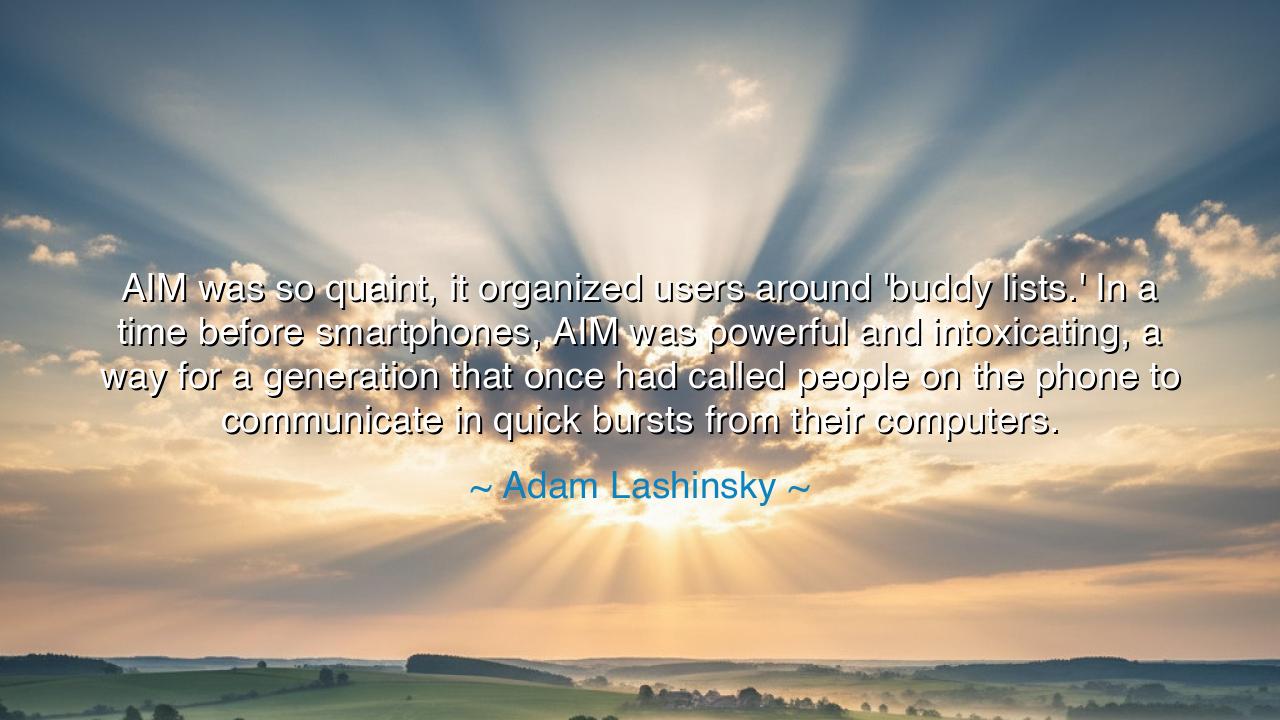
AIM was so quaint, it organized users around 'buddy lists.' In a
AIM was so quaint, it organized users around 'buddy lists.' In a time before smartphones, AIM was powerful and intoxicating, a way for a generation that once had called people on the phone to communicate in quick bursts from their computers.






In the words of Adam Lashinsky, the quote recalls a time when the digital world was still young, when human connection had not yet been swallowed by the endless scroll of social feeds and notifications. He speaks of AIM—AOL Instant Messenger—as something “quaint,” a word that evokes both nostalgia and reverence. It was quaint not because it was simple, but because it was pure. In the era before smartphones, AIM created the first “buddy lists”, small constellations of names glowing beside green dots, representing friends, crushes, rivals—souls connected not by proximity, but by presence. It was a digital hearth, where conversations flickered like campfires in the dark.
In those early days of the internet, to “log on” was an act of intention. You entered a new realm—not to chase likes or followers, but to speak, to listen, and to be heard. Each instant message was a spark of emotion, each sound of the message alert a pulse of excitement. Lashinsky’s reflection reminds us that technology was once not about distraction, but about connection. The “powerful and intoxicating” nature of AIM came from its ability to bridge isolation with immediacy—to make the far feel near and the silent speak.
There is an ancientness to this longing. Just as the Greek agora was once a place for discourse and fellowship, AIM became the virtual meeting ground for a new generation. It was not the place that mattered—it was the presence of others within it. Humanity has always sought communion, from the fires of prehistory to the glow of computer screens. What Lashinsky mourns is not the technology itself, but the spirit of communion that has since become fragmented in the noise of digital modernity. We have replaced buddy lists with followers, and presence with performance.
Consider the story of Tom Anderson, the founder of MySpace. When he launched his platform in 2003, he carried forward the same flame that burned in AIM—creating a space for connection, for belonging. For a while, it worked. Millions found their voice, their tribe, their echo. Yet as the years passed, the purity faded. The digital village became a marketplace. Connection gave way to curation. The warmth of friendship was replaced by the cold arithmetic of algorithms. The story of AIM, and of Tom’s MySpace, are the same parable told twice: that technology, when divorced from empathy, turns from bridge to barrier.
In the tone of the ancients, we may say this: every new invention is a mirror of the human soul. When that soul seeks connection, the invention unites. When it seeks attention, the invention divides. AIM was born from the first instinct; many of today’s platforms are born from the second. To remember AIM is to remember a time when our words still mattered more than our images, when our messages carried the weight of presence rather than the performance of identity.
The lesson is simple but profound: guard the sanctity of your connections. Do not let technology dictate the depth of your relationships. Speak as though your words were carved in stone. Listen as though each message were a heartbeat. Use the tools of the age not to escape reality, but to enrich it. For in every age, the essence of humanity remains the same—the longing to be seen, to be understood, and to belong.
Let us then, like the early users of AIM, curate our own “buddy lists”—not of thousands, but of the few who truly matter. Let us write messages that mean something, and cultivate presence in an age of absence. Technology evolves, but wisdom endures: every click, every word, every connection is a chance to either deepen the human spirit or diminish it. Choose the former, and your presence will echo—like the green light beside an old friend’s name, glowing eternal in the quiet expanse of memory.






AAdministratorAdministrator
Welcome, honored guests. Please leave a comment, we will respond soon